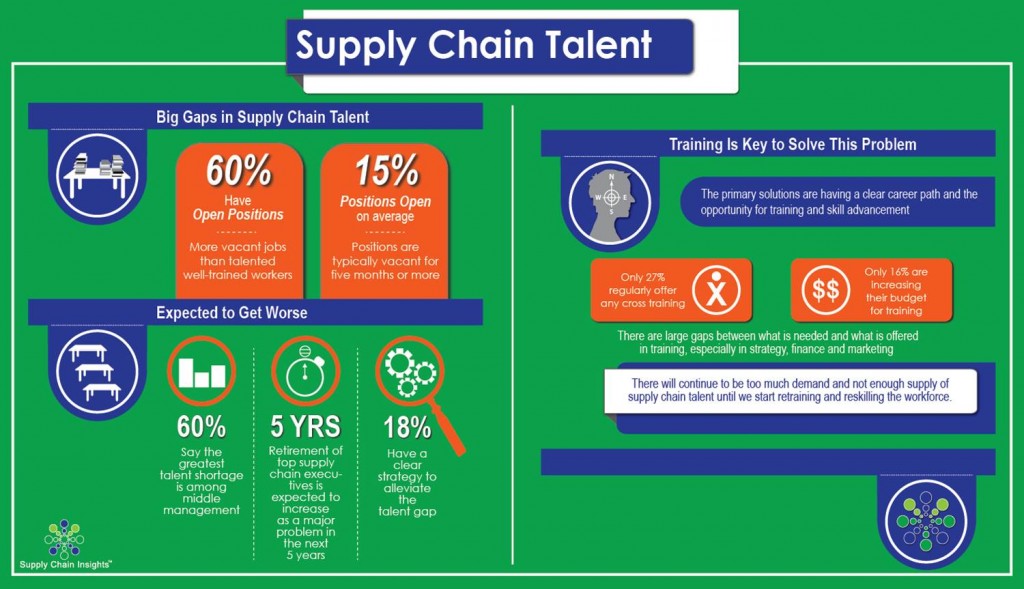In one of our previous blogs, we delved into the crisis of a looming talent gap in the supply chain industry. A large cause for this shortage can be attributed to the fact that over 60 million Baby Boomers are estimated to retire in 2025, but only 40 million new bodies will replace them in the workforce.
Another reason for the shortage is because of the lack of interest that the supply chain industry attracts from current students. It is rare to find an undergraduate student who will find logistics more appealing than the current leading concentrations. This lack of interest is then compounded by the dwindling amount of professors, which had an average of 365 members of faculty between 2009 and 2014 and is slated to shrink to an even more diminutive number in the near future.

Although the supply chain’s impending talent shortage could be calamitous for the industry, there are still measures that could be taken in order to counter it.
- Recruit- Most students do not find a career in the logistics as the most alluring path to take, and this is bewildering because it is such a crucial part of the global economy. Changing the supply chain’s image is the responsibility of the companies within the industry, they must alter the way that students see the supply chain. A perfect example would be Virgin Atlantic who sponsors the British International Freight Association’s Young Freight Forwards of the Year award, or Inbound Logistics’ 30 Under 30 spotlight. More efforts must be made to sell the supply chain industry as a dynamic profession. It does not have to be purely scholarships, for offering paid internships to get some real world experience, and offering to be guest speakers at classes could also help alter the supply chain’s image amongst undergraduates and even high school juniors and seniors.
- Evaluate- Companies must assess the core competencies required in order to thrive in the supply chain industry. This is not as easy as it seems because the responsibilities and required skills that supply chain specialist needs has evolved, and will continue to do so throughout the 21st century. Although “hard” analytical skills are required now, it is projected that three out of four jobs in 2015 will change. It is also estimated that 60 percent of all new jobs in the 21st century will require skills that only 20 percent of the workforce have today. Therefore, the evaluation has to be made with the future in mind.
- Assess- After a company evaluates what competencies are essential, they must then move on to their employees. Supply chain firms must analyze where the disparities between the required competencies and their current employees’ skill sets are in order to move on to the next step of how to beat the supply chain talent drought.
- Train- Once an organization is able to properly assess what their employees’ need, it must also map out their path for growth. Trainings must be implemented in order to retool and reequip the workforce. However, it should be geared more towards a T-shaped talent development approach (The vertical bar on the T represents the depth of related skills and expertise in a single field, whereas the horizontal bar is the ability to collaborate across disciplines with experts in other areas and to apply knowledge in areas of expertise other than one’s own) rather than the traditional tower approach. The T-shaped talent development hones in on core supply-chain technical skills, while simultaneously embracing leadership and globally integrated, cross-functional capabilities. Career roadmaps and opportunities to acquire the skills they need should also be provided to employees in order to retool them, and provide them with a feasible path to gain leadership positions. Each path must be based off of individual skill assessment (to identify skill gaps), learning pace and style, and personal objectives such as progress in life and career. Furthermore, the plan must also be accompanied with detailed goals and a timeline, which will serve as the main way to measure the individual’s growth or if the plan needs to be reevaluated and updated.
- Retain- Because of the demand that a shortage in talent creates, there is an ongoing “free-agent” mentality permeating throughout the industry today. This creates high turnover rates as individuals are willingly leaving their jobs to find opportunities that pay better. According to chief executive officer of BlueWorld Supply Chain Consulting LLC, Jake Barr, “It takes the equivalent of 80 percent of fully loaded salary and benefit costs to train individuals coming in the door to do their base work. It takes 200 percent of fully loaded cost to bring someone in to fill after you lose them.” By applying the previous steps of assessing and training/development, as well as providing incentives for achieving the goals in their path, issues with retention could diminish.
